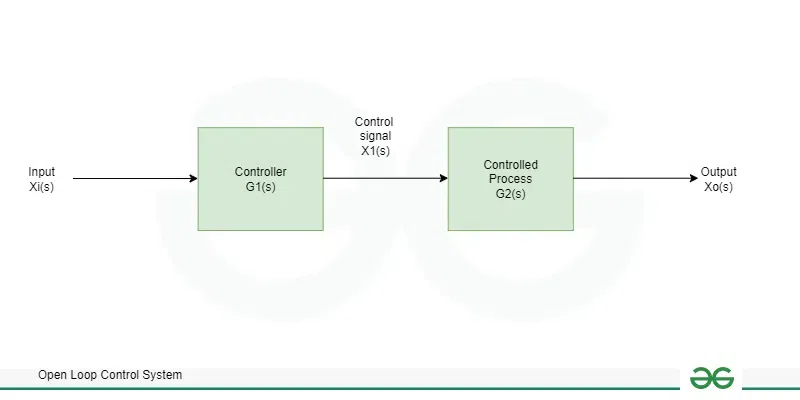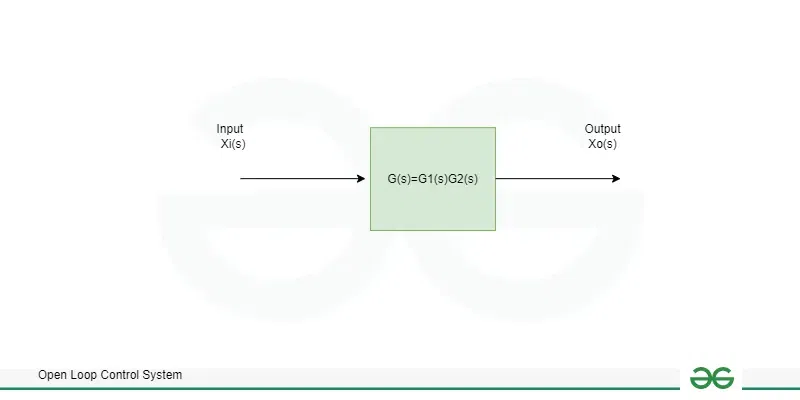Open Loop Control System
Last Updated :
27 Feb, 2024
Control systems are of wide use which can be understood in a better way by the following real-life examples which we use every now and then some of the examples are Regulating the speed of a fan with regulator, Oven temperature control, Washing machine cycle selection based on the type of clothes, Remote control for TV and other electronic devices.
In this article we will be going through an open loop system, We will begin our Article with what is Control System, Then we will Proceed to the definition of the control system and go through its block diagram. Then we will go through the gain of the open loop system and explore its components. At last, we will conclude our Article with Advantages, Disadvantages, Characteristics, and Some FAQs.
Control System
The control system is basically a mechanism to regulate or maintain the output of a system in a desired manner. This Can be Achieved directly by Providing input to the controller and getting the required Output, or by monitoring the System’s output using the feedback and adjusting its input as per the requirement. Based on these scenarios there are primarily two types of control systems:
- Open-loop control system
- Close loop control system
In this article, we are going to have an overview of the open-loop control system. So here is a detailed description of this topic and the other relevant topics of open-loop control systems.
Open Loop Control System
An open loop control system is a type of control system in which the system’s output does not have any effect on its input and, therefore, does not have any feedback.
Open loop system is also known as non feedback control system because it does not depend on the any previous output or any continuous output of the system. In this type of system input is provided to the system and the output is generated without taking any feedback from the output.
Block Diagram of Open Loop Control System
In the Open loop control system the output of the System is fixed accordingly to the input Provided. It does not get influenced by the System’s Feedback. The basic of the Block diagram is given below

Open Loop Control System
In this Block Diagram,
- The Input represents the Desired setpoint that the System should achieve.
- The Controller is like Processing block which Process the input and generates the Control signal based on the Algorithms and Commands provided to it.
- The Controlled Process Represents the Physical System that is controlled by the Controller Block. It could Mechanical, Electrical or any other system based on the Requirements.
- The Output is the response of the system to the control signal generated by the controller.
Gain of Open Loop Control System
The Gain in this system is the Amplification factor applied to input signal to produce the control signal. Let us block diagram where G1(s) is the gain of the Controller block and G2(s) as the gain of the controlled processing unit.

Gain Block diagram
The Gain of the system is the relationship between the magnitude of the input and output Signal.
So, here gain of this system can be represented as,
[Tex]G(s)=\frac{Output Signal}{Input Signal}[/Tex]
G(s)=[Tex]\frac{X_0(s)}{X_i(s)}[/Tex]
Where G(s) is the gain of the system
so in the given block diagram
[Tex]G_1(s)=\frac{X_1(s)}{X_i(s)}[/Tex]
similarly,
[Tex]G_2=\frac{X_0(s)}{X_1(s)}[/Tex]
G(s) can be written as,
[Tex]G(s)=G_1(s) \times G_2(s)[/Tex]
So G(s) can be solved as,
[Tex]G(s)=\frac{X_1(s)}{X_i(s)} \times \frac{X_0(s)}{X_1(s)}=\frac {X_0(s)}{X_i(s)}[/Tex]
So, the new block diagram can be drawn as

Gain of Open Loop Control System
So it can be Written as
G(s)=G1(s)G2(s)
Working of Open Loop Control System
We will be Discussing the Working of the Open Loop Control System
- Firstly the input signal is converted to electronic signal through input device after detection, after this signal passes to the processor for further process.
- Then the controller converts the signal to output signal with the accuracy that the desired the output signal’s value should match with input signal’s value and the signal is send to output device.
- When the input signal is processed through controller and then passed to the output device then the output device converts the signal to electrical signal which controls system’s output.
So that’s how the open loop control system works with the process of the signal and this system is basically used where the output signal is not feedback controlled also this is simple to operate .
Components of Open Loop Control System
Open loop control system generally has three components:
- Input signal: This is the signal provided to the system which is desired to be processed like in case of an electric fan we provide electricity as the input signal.
- Controller or processor: This is basically where the input is passed to for processing and produce the result. For better understanding let’s consider our old example of fan. Here when we pass electricity to the fan then we are intended to have some mechanical energy produced for the electrical energy passed as input, and that task is performed by our controller or processor.
- Output : This is the desired signal for which all of the task is being performed that is output signal. Like in our example of fan the output is that the shaft rotates and ultimately we get the desired output after successful conversion of electric to mechanical energy.
Example for Open Loop Control System
Open-loop control systems find applications in various real-world scenarios
- Electric Fan: As mentioned earlier, the regulation of fan speed using a regulator is a classic example of an open-loop control system. The input is the electrical power, controller is centrally located shaft that rotates and the output is the fan’s rotational speed.
- Oven Temperature Control: Many ovens operate based on open-loop control systems. In this case we set the desired temperature, and the oven heats up to that temperature without continuously monitoring the actual temperature.
- Washing Machine Cycle Selection: When we choose a washing machine cycle based on the type of clothes, the machine follows a predefined program without constantly measuring the water temperature or the state of the clothes.
- Remote Control for Electronic Devices: Remote controls for TVs and other electronic devices send commands without receiving feedback about whether the device successfully executed the command.
Characteristics of an Open Loop Control System
Characteristics of the Control systems are given below
- No Feedback: In this System there is no feedback from the output to adjust the input of the system so, the errors and disturbances cannot be corrected.
- Stability: As there is absence of the feedback in the system, the errors in the system is not corrected which leads to reduce the stability of the system.
- Fast Response: Open loop System can Provide fast feedback as there is no feedback loop present.
- Simple Design: These systems are simpler in design compared to closed-loop systems.
Applications of Open loop Control System
Open-loop control systems are well-suited for applications where precise control and feedback are not critical. Some common applications include:
- Light Switches: Turning on/off a light switch is a simple open-loop control system application.
- Simple Appliances: Devices like blenders and toasters often use open-loop control for basic operations.
- Traffic Signals: Traffic lights follow predefined schedules without adjusting to real-time traffic conditions.
- Robotics: This system can be implemented in the simple robotics where precise feedback is not required.
- Manufacturing Processes: This system can be used to control parameters such as temperature, pressure ,speed based on the Setpoints.
Advantages and Disadvantages of Open Loop Control System
Given below are some Advantages and Disadvantages of Open Loop Control System
Advantages
- Cost Effectiveness: This configuration is simple to design and cost effective since it utilizes straight network and the feedback path needs not to be considered.
- Easy to maintain: This configuration is easy to maintain as and when any error occurs it gets easily detected due to simplicity in the circuit design.
- Fast response: Due to minimal circuitry fast response is associated with this type of configuration since feedback path is not involved so the delay is also less.
Disadvantages
- Less accurate: As there is no check in the output produced because feedback is not there so the accuracy of this type of system is slightly compromised.
- Limited Adaptability: This system works based on the Predefined inputs and Doesn’t dynamically Adapts to the changes.
- Lack of Robustness: Due to their reliance on predetermined control signals, open-loop systems may be less robust in dealing with uncertainties or unexpected events
Conclusion
In this article we learnt about the open loop control system. Open loop control system takes the input which is processed via controller and produces the output. This article explains about the various components of an open loop control system, advantages and disadvantages of control system and also the the effect of parametric variation on transfer function of open loop control system which helps in better understanding of the article.
FAQs on Open Loop Control System
What are the main differences between open-loop and closed-loop control systems?
Open-loop systems do not utilize feedback from the output to adjust the input, while closed-loop systems uses feedback for error correction and precise control.
Why open loop control system is specifically called “open loop”?
It is because in this type of control system there is no feedback loop to the input of the system.
What is the role of the controller in an open loop system?
Controller in an open loop system is responsible for processing the input passed to it and produce the desired output of the system.
Share your thoughts in the comments
Please Login to comment...